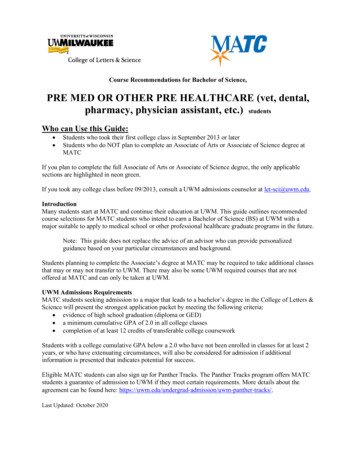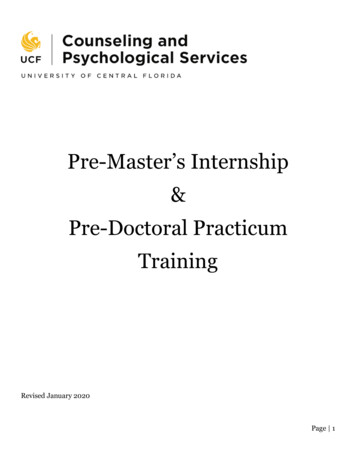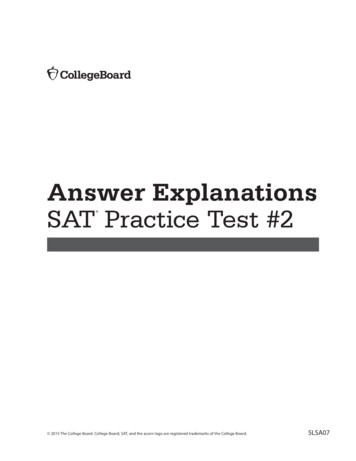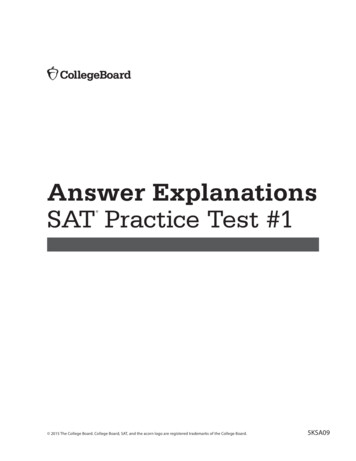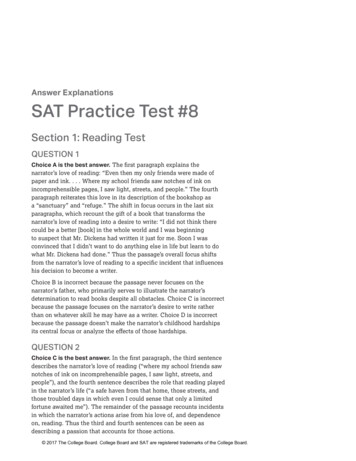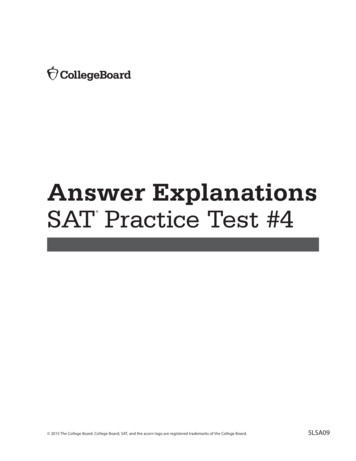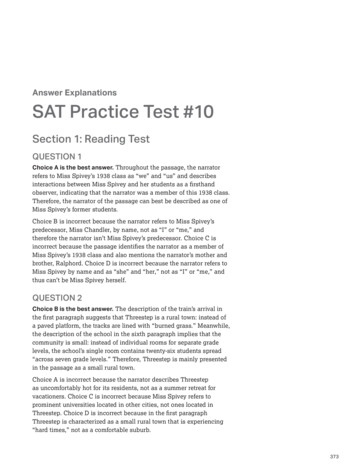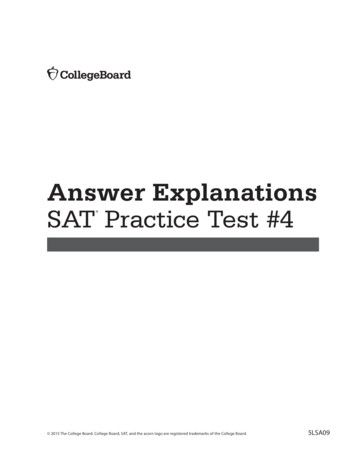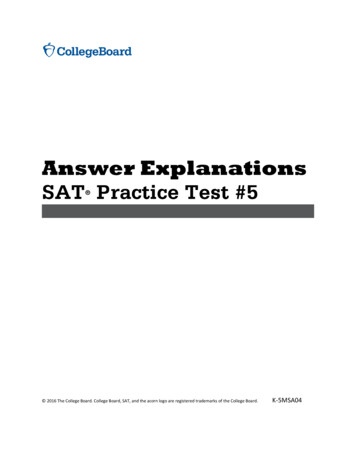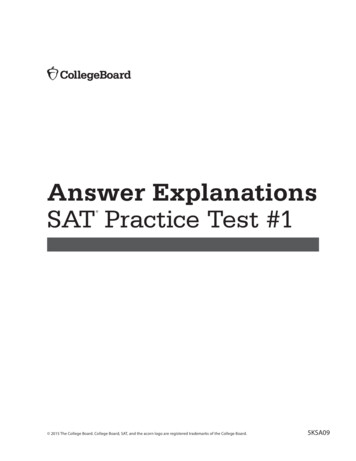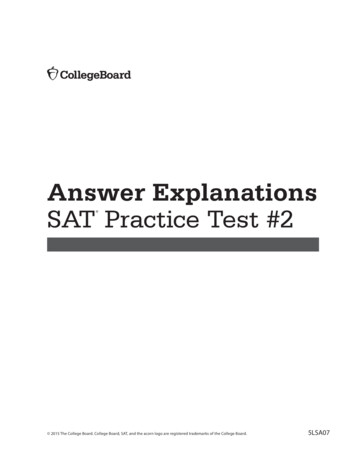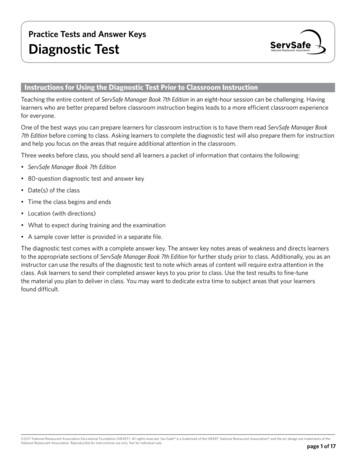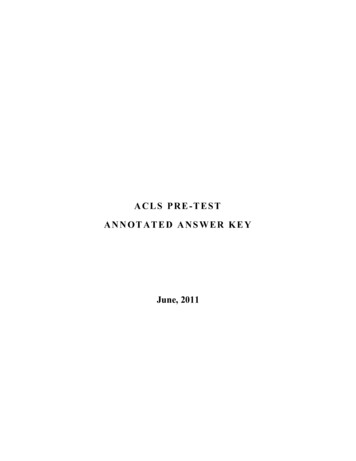
Transcription
ACLS PRE-TESTANNOTATED ANSWER KEYJune, 2011
Question 1:Please identify the rhythm by selecting the best single answerAgonal rhythm/asystoleAtrial fibrillationAtrial flutterCoarse ventricular fibrillationFine ventricular fibrillationMonomorphic ventricular tachycardiaNormal sinus rhythmPolymorphic ventricular tachycardiaXPulseless electrical activityReentry supraventricular tachycardiaSecond-degree AC block (Mobitz I Wenckebach)Second-degree AV block (Mobitz II block)Sinus bradycardiaSinus tachycardiaThird-degree AV blockQuestion 2:There is no pulse with this rhythm. Please identify the rhythm by selecting the best single answerAgonal rhythm/asystolePulseless electrical activityXAtrial fibrillationReentry supraventricular tachycardiaAtrial flutterSecond-degree AC block (Mobitz I Wenckebach)Coarse ventricular fibrillationSecond-degree AV block (Mobitz II block)Fine ventricular fibrillationSinus bradycardiaMonomorphic ventricular tachycardiaSinus tachycardiaNormal sinus rhythmThird-degree AV blockPolymorphic ventricular tachycardiaQuestion 3:Please identify the rhythm by selecting the best single answerAgonal rhythm/asystoleAtrial fibrillationAtrial flutterX Coarse ventricular fibrillationPulseless electrical activityReentry supraventricular tachycardiaSecond-degree AC block (Mobitz I Wenckebach)Second-degree AV block (Mobitz II block)
Fine ventricular fibrillationMonomorphic ventricular tachycardiaNormal sinus rhythmPolymorphic ventricular tachycardiaSinus bradycardiaSinus tachycardiaThird-degree AV blockQuestion 4:Please identify the rhythm by selecting the best single answerAgonal rhythm/asystolePulseless electrical activityAtrial fibrillationReentry supraventricular tachycardiaXAtrial flutterSecond-degree AC block (Mobitz I Wenckebach)Coarse ventricular fibrillationSecond-degree AV block (Mobitz II block)Fine ventricular fibrillationSinus bradycardiaMonomorphic ventricular tachycardiaSinus tachycardiaNormal sinus rhythmThird-degree AV blockPolymorphic ventricular tachycardiaQuestion 5:Please identify the rhythm by selecting the best single answerAgonal rhythm/asystoleAtrial fibrillationAtrial flutterCoarse ventricular fibrillationFine ventricular fibrillationMonomorphic ventricular tachycardiaNormal sinus rhythmPolymorphic ventricular tachycardiaQuestion 6:XPulseless electrical activityReentry supraventricular tachycardiaSecond-degree AC block (Mobitz I Wenckebach)Second-degree AV block (Mobitz II block)Sinus bradycardiaSinus tachycardiaThird-degree AV block
Please identify the rhythm by selecting the best single answerPulseless electrical activityAgonal rhythm/asystoleAtrial fibrillationReentry supraventricular tachycardiaAtrial flutterSecond-degree AC block (Mobitz I Wenckebach)Coarse ventricular fibrillationSecond-degree AV block (Mobitz II block)Fine ventricular fibrillationSinus bradycardiaMonomorphic ventricular tachycardiaSinus tachycardiaNormal sinus rhythmThird-degree AV blockX Polymorphic ventricular tachycardiaQuestion 7:Please identify the rhythm by selecting the best single answerAgonal rhythm/asystolePulseless electrical activityAtrial fibrillationReentry supraventricular tachycardiaAtrial flutterSecond-degree AC block (Mobitz I Wenckebach)Coarse ventricular fibrillationSecond-degree AV block (Mobitz II block)XFine ventricular fibrillationSinus bradycardiaMonomorphic ventricular tachycardiaSinus tachycardiaNormal sinus rhythmThird-degree AV blockPolymorphic ventricular tachycardiaQuestion 8:Please identify the rhythm by selecting the best single answerPulseless electrical activityAgonal rhythm/asystoleAtrial fibrillationReentry supraventricular tachycardiaXAtrial flutterSecond-degree AC block (Mobitz I Wenckebach)Coarse ventricular fibrillationSecond-degree AV block (Mobitz II block)Fine ventricular fibrillationSinus bradycardiaMonomorphic ventricular tachycardiaSinus tachycardiaNormal sinus rhythmThird-degree AV blockPolymorphic ventricular tachycardia
Question 9:Please identify the rhythm by selecting the best single answerAgonal rhythm/asystolePulseless electrical activityAtrial fibrillationReentry supraventricular tachycardiaAtrial flutterSecond-degree AC block (Mobitz I Wenckebach)Coarse ventricular fibrillationSecond-degree AV block (Mobitz II block)XFine ventricular fibrillationSinus bradycardiaMonomorphic ventricular tachycardiaSinus tachycardiaNormal sinus rhythmThird-degree AV blockPolymorphic ventricular tachycardiaQuestion 10:Please identify the rhythm by selecting the best single answerAgonal rhythm/asystolePulseless electrical activityAtrial fibrillationReentry supraventricular tachycardiaAtrial flutterSecond-degree AC block (Mobitz I Wenckebach)Coarse ventricular fibrillationSecond-degree AV block (Mobitz II block)Fine ventricular fibrillationSinus bradycardiaXMonomorphic ventricular tachycardiaSinus tachycardiaNormal sinus rhythmThird-degree AV blockPolymorphic ventricular tachycardiaQuestion 11:Please identify the rhythm by selecting the best single answerAgonal rhythm/asystolePulseless electrical activityAtrial fibrillationReentry supraventricular tachycardiaAtrialflutterSecond-degree AC block (Mobitz I Wenckebach)XCoarse ventricular fibrillationSecond-degree AV block (Mobitz II block)Fine ventricular fibrillationSinus bradycardia
Monomorphic ventricular tachycardiaNormal sinus rhythmPolymorphic ventricular tachycardiaSinus tachycardiaThird-degree AV blockQuestion 12:Please identify the rhythm by selecting the best single answerAgonal rhythm/asystolePulseless electrical activityAtrial fibrillationReentry supraventricular tachycardiaXAtrial flutterSecond-degree AC block (Mobitz I Wenckebach)Coarse ventricular fibrillationSecond-degree AV block (Mobitz II block)Fine ventricular fibrillationSinus bradycardiaMonomorphic ventricular tachycardiaSinus tachycardiaNormal sinus rhythmThird-degree AV blockPolymorphic ventricular tachycardiaQuestion 13:Please identify the rhythm by selecting the best single answerPulseless electrical activityAgonal rhythm/asystoleAtrial fibrillationReentry supraventricular tachycardiaAtrial flutterSecond-degree AC block (Mobitz I Wenckebach)Coarse ventricular fibrillationSecond-degree AV block (Mobitz II block)Fine ventricular fibrillationSinus bradycardiaSinus tachycardiaX Monomorphic ventricular tachycardiaNormal sinus rhythmThird-degree AV blockPolymorphic ventricular tachycardiaQuestion 14:
Please identify the rhythm by selecting the best single answerPulseless electrical activityAgonal rhythm/asystoleAtrial fibrillationReentry supraventricular tachycardiaAtrial flutterSecond-degree AC block (Mobitz I Wenckebach)XCoarse ventricular fibrillationSecond-degree AV block (Mobitz II block)Fine ventricular fibrillationSinus bradycardiaMonomorphic ventricular tachycardiaSinus tachycardiaNormal sinus rhythmThird-degree AV blockPolymorphic ventricular tachycardiaQuestion 15:Please identify the rhythm by selecting the best single answerAgonal rhythm/asystolePulseless electrical activityAtrial fibrillationReentry supraventricular tachycardiaAtrial flutterSecond-degree AC block (Mobitz I Wenckebach)Coarse ventricular fibrillationSecond-degree AV block (Mobitz II block)Fine ventricular fibrillationSinus bradycardiaMonomorphic ventricular tachycardiaSinus tachycardiaThird-degree AV blockX Normal sinus rhythmPolymorphic ventricular tachycardiaQuestion 16:Please identify the rhythm by selecting the best single answerPulseless electrical activityX Agonal rhythm/asystoleAtrial fibrillationReentry supraventricular tachycardiaAtrial flutterSecond-degree AC block (Mobitz I Wenckebach)Coarse ventricular fibrillationSecond-degree AV block (Mobitz II block)Fine ventricular fibrillationSinus bradycardiaMonomorphic ventricular tachycardiaSinus tachycardiaNormal sinus rhythmThird-degree AV blockPolymorphic ventricular tachycardia
Question 17:Please identify the rhythm by selecting the best single answerAgonal rhythm/asystolePulseless electrical activityReentry supraventricular tachycardiaX Atrial fibrillationAtrial flutterSecond-degree AC block (Mobitz I Wenckebach)Coarse ventricular fibrillationSecond-degree AV block (Mobitz II block)Fine ventricular fibrillationSinus bradycardiaMonomorphic ventricular tachycardiaSinus tachycardiaNormal sinus rhythmThird-degree AV blockPolymorphic ventricular tachycardiaQuestion 18:Please identify the rhythm by selecting the best single answerAgonal rhythm/asystolePulseless electrical activityAtrial fibrillationReentry supraventricular tachycardiaAtrial flutterSecond-degree AC block (Mobitz I Wenckebach)Coarse ventricular fibrillationSecond-degree AV block (Mobitz II block)Fine ventricular fibrillationSinus bradycardiaMonomorphic ventricular tachycardiaSinus tachycardiaXNormal sinus rhythmThird-degree AV blockPolymorphic ventricular tachycardiaQuestion 19:Please identify the rhythm by selecting the best single answerAgonal rhythm/asystolePulseless electrical activityAtrial fibrillationReentry supraventricular tachycardiaAtrial flutterSecond-degree AC block (Mobitz I Wenckebach)XCoarse ventricular fibrillationSecond-degree AV block (Mobitz II block)X Fine ventricular fibrillationSinus bradycardia
Monomorphic ventricular tachycardiaNormal sinus rhythmPolymorphic ventricular tachycardiaSinus tachycardiaThird-degree AV blockQuestion 20:Please identify the rhythm by selecting the best single answerPulseless electrical activityAgonal rhythm/asystoleAtrial fibrillationReentry supraventricular tachycardiaAtrial flutterSecond-degree AC block (Mobitz I Wenckebach)Second-degree AV block (Mobitz II block)X Coarse ventricular fibrillationFine ventricular fibrillationSinus bradycardiaMonomorphic ventricular tachycardiaSinus tachycardiaNormal sinus rhythmThird-degree AV blockPolymorphic ventricular tachycardiaQuestion 21: Which of the following statements about the use of magnesium in cardiac arrest is most accurate?XMagnesium is indicated for shock-refractory monomorphic VT.Magnesium is indicated for VF/pulseless VT associated with torsades de pointes.Magnesium is contraindicated for VT associated with a normal QT interval.Magnesium is indicated for VF refractory to shock and amiodarone or lidocaine.Question 22: A patient with ST-segment elevation MI has ongoing chest discomfort. Fibrinolytic therapy hasbeen ordered. Heparin 4000 units IV bolus was administered, and a heparin infusion of 1000 units per hour isbeing administered. Aspirin was not taken by the patient because he had a history of gastritis treated 5 yearsago. Your next action is to:X Give aspirin 160 to 325 mg chewed immediately.Give 75 mg enteric-coated aspirin orally.Give 325 mg enteric-coated aspirin rectally.Substitute clopidogrel 300 mg loading dose.Question 23: A patient has sinus bradycardia with a heart rate of 36/min. Atropine has been administered to atotal of 3 mg. A transcutaneous pacemaker has failed to capture. The patient is confused, and her blood pressureis 110/60 mm Hg. Which of the following is now indicated?Give additional 1 mg atropine.Start dopamine 10 to 20 mcg/kg per minute.Give normal saline bolus 250 mL to 500 mL.X Start epinephrine 2 to 10 mcg/min.
Question 24: A 62-year-old man suddenly experienced difficulty speaking and left-side weakness. He wasbrought to the emergency department. He meets initial criteria for fibrinolytic therapy, and a CT scan of thebrain is ordered. What are the guidelines for antiplatelet and fibrinolytic therapy XDo not give aspirin for at least 24 hours if rtPA is administered.Give aspirin 160 mg and clopidogrel 75 mg orally.Administer heparin if CT scan is negative for hemorrhage.Administer aspirin 160 to 325 mg chewed immediately.Question 25: A patient with possible ST-segment elevation MI has ongoing chest discomfort. Which of thefollowing would be a contraindication to the administration of nitrates?XHeart rate 90/min.Left ventricular infarct with bilateral rales.Blood pressure greater than 180 mm Hg.Use of a phosphodiesterase inhibitor within 12 hoursQuestion 26: A patient is in cardiac arrest. Ventricular fibrillation has been refractory to a second shock. Of thefollowing, which drug and dose should be administered first by the IV/IO route?XEpinephrine 1 mgVasopressin 20 unitsSodium bicarbonate 50 mEqAtropine 1 mgQuestion 27: A 35-year-old woman has palpitations, light-headedness, and a stable tachycardia. The monitorshows a regular narrow-complex QRS at a rate of 180/min. Vagal maneuvers have not been effective interminating the rhythm. An IV has been established. What drug should be administered IV?XLidocaine 1mg/kgAdenosine 6 mgEpinephrine 2 to 10 mcg/kg per minuteAtropine 0.5 mgQuestion 28: A patient with sinus bradycardia and heart rate of 42/min has diaphoresis and a blood pressure of80/60 mm Hg. What is the initial dose of atropine?X0.1mg3 mg1 mg0.5 mgQuestion 29: A patient is in refractory ventricular fibrillation and has received multiple appropriatedefibrillation shocks, epinephrine 1 mg IV twice, and an initial dose of 300 mg amiodarone IV. The patient isintubated. A second dose of amiodarone is now called for. The recommended second dose of amiodarone is:XAn endotracheal dose of 2 to 4 mg/kg.300 mg IV push.1 mg/kg IV push.An infusion of 1 to 2 mg/min.150 mg IV push.
Question 30: A patient with a possible acute coronary syndrome has ongoing chest discomfort unresponsive to3 sublingual nitroglycerin tablets. There are no contraindications, and 4 mg of morphine sulfate wasadministered. Shortly afterward, blood pressure falls to 88/60 mm Hg, and the patient has increased chestdiscomfort. You should:XGive normal saline 250 mL to 500 mL fluid bolus.Give an additional 2 mg of morphine sulfate.Give sublingual nitroglycerin 0.4 mg.Start dopamine at 2 mcg/kg per minute and titrate to a systolic blood pressure reading of 100 mm Hg.Question 31: A patient has a rapid irregular wide-complex tachycardia. The ventricular rate is 138/min. He isasymptomatic, with a blood pressure of 110/70 mm Hg. He has a history o
ACLS PRE-TEST ANNOTATED ANSWER KEY June, 2011 . Question 1: Please identify the rhythm by selecting the best single answer Agonal rhythm/asystole Pulseless electrical activity Atrial fibrillation Reentry supraventricular tachycardia Atrial flutter Second-degree AC block (Mobitz I Wenckebach) Coarse ventricular fibrillation Second-degree AV block (Mobitz II block) Fine ventricular fibrillation .
